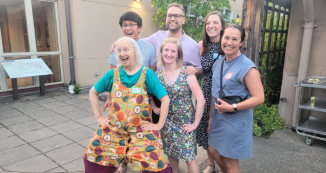
13 Sep Six Building Blocks In-Action: A Step Toward Solving the Opioid Crisis
The Six Building Blocks or 6BBs is a team-based intervention for improving opioid prescribing and management that provides quality improvement facilitation, mentored clinical guidance, tools and resources to clinics seeking to effectively manage their patients with chronic pain using opioid medication. It is led by Michael Parchman, MD, MPH, Senior Investigator at Kaiser Permanente Health Research Institute, and the ITHS’ Senior Advisor to the Community Engagement Program, Laura-Mae Baldwin, MD, MPH. It is a program to help mitigate the opioid crisis. According to the NIH National Institute on Drug Abuse, “In 2017, more than 47,000 Americans died from opioid overdose … and an estimated 1.7 million people suffered from substance use disorders related to prescription opioid pain relievers.” The opioid management improvements that clinics implement through the 6BBs build their capacity to help patients with chronic pain maximize their function and quality of life with a treatment plan that minimizes the risks of opioid medications, such as overdose.
In 2017, more than 47,000 Americans died from opioid overdose … and an estimated 1.7 million people suffered from substance use disorders related to prescription opioid pain relievers.



In 2016, Drs. Parchman and Baldwin, along with the project’s research scientist and practice facilitator Brooke Ike, MPH, worked with their research team to provide support to implement the 6BBs in 20 rural clinics. As a result, these clinics decreased both the number of patients using long-term opioid therapy and the proportion using high dose opioid therapy. Detailed results from the 6BBs program can be found in Annals of Family Medicine and the Journal of the American Board of Family Medicine. These publications prompted the ITHS Research Connector to learn more about the 6BBs successes and opportunities from the perspective of rural clinics that participated in the program. Dr. Baldwin identified two physicians in the WWAMI region who could share their experience implementing the 6BBs. Ross Bethel, MD, was the physician champion for the project at Yakima Memorial Physicians; and Jeffrey Kaplan, MD was the Medical Director for the outpatient clinics in Yakima and now is Deputy Director of Quality for Memorial Physicians. A series of questions led our conversation. Here is their story.
What were the improvements that you observed from before and after the 6BBs were implemented?
DR. BETHEL: I think before there was a lot of fear that this prescription I’m giving is for someone who is abusing or somebody who is manipulating the doctor or something like that. In the past I had more pain patients than my partners in my clinic and if I was out of town or on vacation there was quite a bit of anxiety over getting refills done …really there was chaos; negativity both towards the patient and sometimes between doctors. Now that we have a very clear workflow, all of the MA’s [medical assistants] know ―here’s the steps we go through. When someone comes for a refill, we see when their last refill was. We look and see if they had a pain agreement and if they haven’t, we know they have to come in and they can get scheduled. They look at the state registry and can say we are confident they’re not getting meds from somebody else.
DR. KAPLAN: Patients are confident that they are being managed correctly and they are actually, in my experience, comfortable with this process. I think that clinicians have become much more confident having these difficult discussions and managing the population in a respectful way. I think it has been an example of a topic that frequently was either avoided or stigmatized, and now it has been normalized.
DR. BETHEL: Also, part of the steps we are doing now that we didn’t do before is functional goal setting, which are part of the Six Building Blocks. So, it’s really made a significant difference for many patients at decreasing their dose. I’ve had quite a few patients either come off of opioids or decrease their dose to significant amount because of the fact that we are having these goal setting conversations.
What is goal setting?
DR. BETHEL: There was this belief that the pain level was what we should go by. We are now learning that the pain level is important and how someone perceives pain, but that is so variable based on depression, based on previous drug addiction, other things that make you hurt more. But how much is pain affecting your general activity? That’s the PEG score. Your pain level, your enjoyment level and your general activity level. So, we do all three of those instead of just how is your pain. That does help us to refocus away from the pain and setting functional goals.
How long did it take to establish the 6BBs system and infrastructure?
DR. KAPLAN: It was a full year on the ground to build the structures and have Ross work through documents and build teams.
DR. BETHEL: We had amazing IT people building the registry [of patients using long-term opioid therapy] and that went surprisingly fast. The University [University of Washington] helped us make this registry. That was definitely crucial. Our electronic medical record will automatically populate the registry based on criteria that we have. And that involves how many prescriptions for opioids they’ve had within a certain timeframe and allows us to see who’s getting medicines, drug screens, and if they’ve had a pain agreement, so all of the safety items were checked off because of the registry.
There’s surprising amount of data showing that a few doses of opioids can start to develop tolerance and habituation … Yes, they do treat pain in the short term, but do they solve the issue of pain? No.
Are we moving towards not prescribing opioids at all?
DR. BETHEL: Yes, not to an area that we will never prescribe opioids, but there are conditions where we are saying we shouldn’t prescribe opioids for someone that comes in with just a little back pain. There’s good data showing that those don’t help the problem. There’s surprising amount of data showing that a few doses of opioids can start to develop tolerance and habituation and these other things that we worry about. Yes, they do treat pain in the short term, but do they solve the issue of pain? No.
DR. KAPLAN: Since pain is complex, there are many different modalities that can help people with their discomfort, and it is reaching that person where they are. Some of the modalities include acupuncture; massage and now more people are trying CBD instead of opioids.
What would you like to see in the future moving forward from what you have achieved with the 6 BB’s?
DR. KAPLAN: I think the first thing I would like to see is a model that is implemented more widely, so that the successes are felt hopefully in every community in ways that we all learn from each other and make it better.
DR. BETHEL: One thing I think we need to do a better job of is getting treatments available. So if we discover someone with opioid use disorder, the treatment is limited, we don’t have enough mental health. We don’t have enough suboxone providers right now.
So, if I have somebody embedded in my clinic, where I can say, hey, can you come help me with this difficult patient? They have a lot of pain, but their pain is amplified by their really difficult social setting. How can we improve that? How can we teach them meditation techniques to get their anxiety under control? If we can more holistically involve physical therapy and psychology in the management of our complex chronic pain patients, it’s going to make it easier for me.
So integrating multiple aspects of care into the primary care setting I think will help in the long term. Some rural communities don’t have access to that. We want to try to move towards that, but again finding mental health providers to incorporate into our clinic is difficult.
Can you share some data that supports the success you had in your region as a result of implementing the 6BBs?
DR. KAPLAN: We’ve had 25 percent reduction in the number of people who were getting opioids in our primary care system1
DR. BETHEL: The fact that we can talk about data and the degree our registry shrunk in a period of time is one of the successes of the Six Building Blocks.
The fact that we can talk about data and the degree that our registry shrunk in a period of time is one of the successes of the Six Building Blocks.
What things can help the successful implementation of the 6 BBs?
DR. KAPLAN: You have to have strong leadership support. In the absence of leadership support from the top, it won’t go anywhere. It goes beyond that. There is no way that without the board and the top of the organization, with Dr. Parchman and Dr. Baldwin fully backing us that we would have been able to do this.
The second thing that can’t be overestimated is you have to have access to and control of the data; in order to know where your problems are and then follow them up.
And the third thing would be, it’s a dynamic process not a static one. So I think what you’re hearing Ross [Dr. Bethel] describe is we’ve made headway on one part of a very large problem, but there’s a whole bunch of other aspects to it and you have to just keep working it, to keep getting better. It’s an iterative process where you keep looking for ways to decrease the magnitude of the problem.
Many of us are very grateful to Dr. Baldwin and Dr. Parchman and Brooke and that whole team for helping us with this and inviting us to join it. I will always be grateful for them helping us turn a corner on this issue.
There is not an easy solution or a one-way approach to the opioid crisis. It is a complex problem involving multiple underlying physiological, psychological and sociological issues that need to be taken into consideration when treating patients and developing improvement approaches. The good news is that groups throughout the U.S. are working on innovative solutions like the 6BBs to help solve this crisis. The 6BBs is a crucial step within clinics that will help prepare our affected communities and gear them towards the path of healing and recovery.
1 As of September 2016 the registry that includes all six primary care clinics located in Yakima, Selah and Zillah had 1175 patients. As of June 2019 the registry has 914 patients. This is a decrease in overall registry size of 22%.
LEARN MORE
- Six Building Blocks website: Learn about the building blocks and how to use them
- Read articles about the Six Building Blocks:
- Read UW Medicine Newsroom article: Six ways to manage opioids in small, rural clinics







